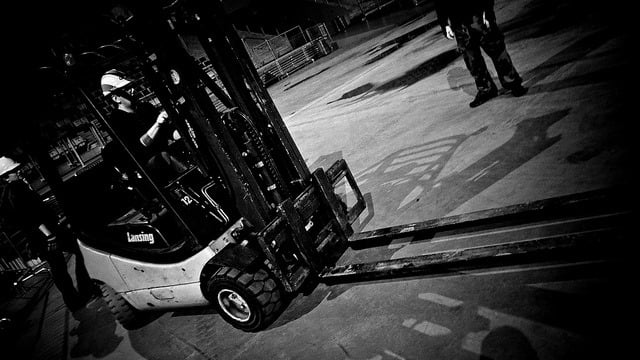A warehouse does not operate on forklift trucks, alone. Rather, the warehouse and work site act as an organism, with many moving parts acting together for a greater good. The forklift is one of the most important parts, but all of the mechanical handling equipment (MHE) is required for a healthy operation.
There are four major categories of MHE:
- Transport Equipment
- Positioning Equipment
- Unit Load Formation Equipment
- Storage Equipment
In order to maximize efficiency within the warehouse, a site should have a proper ratio of MHE to the operation’s needs, as well as operators trained to drive or use equipment required for their respective responsibilities. Also, consider keeping warehouse space available and flexibility within your budget to add trucks and equipment as your business evolves. This way, you can take on new or different tasks within your operation without needing to move around funds or clear out new storage space.
Transport Equipment
Any equipment used to transport or move materials from one location to another falls into this category. This may, at first, seem like it would just be discussing moving materials from one site to another, but the word “move” is quite literal – transport equipment covers moving materials from a loading dock to storage area or just from one end of the warehouse to the other.
Transport Equipment includes:
- Conveyors: used when materials are moved over a consistent path. Traditional factory conveyor belts are usually the first MHEs that pop into one’s head, but conveyors can also be overhead or in-floor.
- Cranes: are used to move materials over a variable path (height and distance) and when the need or volume of movement is intermittent enough that a conveyor is not required. Cranes are also more versatile than conveyors, because they have greater flexibility in handling the shape, size and weight of a load.
- Industrial Trucks: are used to move material over variable paths, and they are not licensed to travel on roadways. These include (but are not limited to) hand trucks, pallet jacks, and counterbalance trucks. Forklifts are counterbalance trucks but trucks can be fitted with accessories besides forks.
Position Handling Equipment
As the name implies, this type of MHE is used to move, handle, and manipulate materials in a single location. Think of moving the silverware from a kitchen drawer to the dinner table as the transportation. Picking a pile of silverware up and setting the table is the positioning. This equipment is mostly used to shift, load/unload, turn, or anything else necessary to make materials ready for their next handling.
Position Handling Equipment includes:
- Lift, Tilt, or Turn Tables
- Dock Leveler: compensates for differences in height between the loading dock and a truck bed.
- Hoist: utilized when lifting or lowering materials.
Unit Load Formation Equipment
This type of MHE is charged with prepping and securing materials for transportation and for storage. The equipment will restrict materials so that those materials retain their integrity and positioning during movement.
Unit Load Formation Equipment includes:
- Pallets: Wooden platforms with enough clearance beneath the top surface for insertion of a forklift fork.
- Skids Metal platforms with enough clearance beneath them for platform or forklift trucks.
- Totes, Boxes, Cartons: All different styles of containers used to unitize and protect materials.
Storage Equipment
Storage equipment is used to store, house, or buffer materials. This equipment includes:
- Selective Pallet Racks: The most popular type of storage MHE, in which pallets are stored on load bearing beams.
- Drive Through Racks: Another form of pallet storage, in these racks, the load is supported by horizontal rails that are fastened to vertical beams. The pallet is driven into the storage space between the beams – picture pulling into a garage that’s open on both ends.
None of the lists above are exhaustive – there are many types of MHE that are essential to and can benefit an operation. If you are a warehouse manager who would like help creating a more efficient workplace, or you just have questions about MHEs and other site related topics, feel free to call HCO Innovations at 888-755-9566 or contact us through our website.

